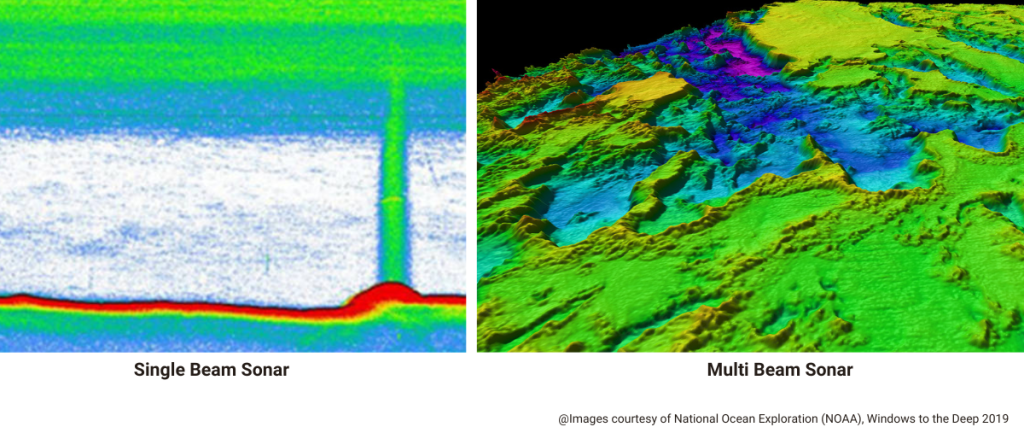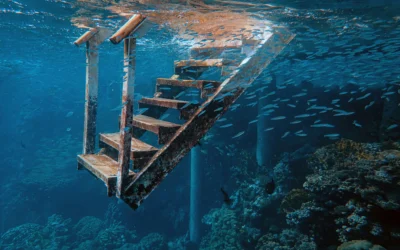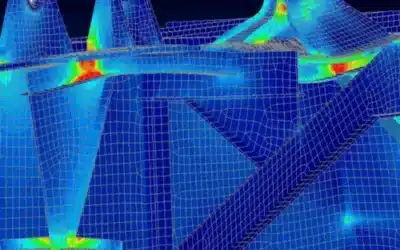It is widely understood that much more is known about outer space than the depths of our oceans, greater than 80% are yet to be explored or charted. The challenges of exploring and understanding what lies beneath the water’s surface are characterised by frigid temperatures, intense, exponential pressures and challenging visibility.
What’s going on down there?
Marine protection, resources, renewable energy and defence & surveillance concerns require significant investment in the information gleaned from sub-surface data acquisition. But acquiring this imperative knowledge presents significant and often dangerous challenges. Factor in the necessity for hyper-precise accuracy and massive data sets and these challenges multiply, quickly.
There are currently ingenious teams working within the subsea sonar imaging and data acquisition sector developing and operating ocean sensor services that provide invaluable knowledge to their clients. Ocean mapping and surveying are key offerings of hydrographic and bathymetric survey companies in North America and abroad.
In recent years, immense strides have been made in the technology used to survey the ocean. Research and defence operators are reaching out to established companies such as Kongsberg and Norbit to provide them with the innovative technology needed to accurately ascertain the seascape, environment and targets of interest.

Kongsberg EM2040C multibeam sonar head
These activities however can involve a lot of factors and moving parts. Sea state, weather, capable crew, operators, and product performance all have drastically significant effect on outcomes and results. Among the most important of factors is the actual deployment of the sonar.
How were the HMS Terror and HMS Erebus found?
In 2014, after years of extensive searching, the wreck of HMS Erebus, one of the two ships lost during Sir John Franklin’s ill-fated 1845 expedition, was found near King William Island, Canada. The breakthrough came thanks to the collaborative efforts of Parks Canada, the Canadian Coast Guard, and Inuit oral histories, which provided crucial clues.
Underwater archeological technology, such as side-scan sonar and remotely operated vehicles (ROVs), played a pivotal role in locating the wreck.
Two years later, in 2016, the wreck of the second ship, HMS Terror, was discovered in Terror Bay, largely intact. These discoveries have shed new light on the tragic fate of the Franklin expedition, offering invaluable insights into 19th-century Arctic exploration and navigation challenges.
Vessels of Opportunity
Traditionally, a “Vessel of Opportunity” is used in the context of emergency relief or disaster response when a vessel is repurposed for a task outside its original intent. However, this definition extends crucially to vessels that can be rapidly repurposed as effective mapping or surveillance vessels.
From Cape Islanders to RHIBs and Carolina Skiffs to pilot boats, with so much information below sea-level to be acquired, organisations are exploring all opportunities.
Both public and private sector stakeholders have many considerations before beginning operations; the type of sonar, Multibeam or Single (split) beam, most suitable to the job and the vessel that is available for their application. The type of deployment is of equal importance and is dictated by the vessel available. Typically, SONAR transponders are deployed over the side or through the hull, both approaches have pros and cons.
Through Hull Deployment
This deployment method is favoured for its direct and uninterrupted signal, resulting in more accurate and reliable sonar readings. This does require modifying the hull. However, this modification allows the sonar transducer to be deployed to optimal depths and retracted safely and securely.
Mounting and deploying below the centreline of the hull significantly reduces inherent vibration and cavitation on the Echo Sounder resulting in imaging that is free of “noise”.
The process begins by preparing the hull. Enginuity’s marine and mechanical teams carefully select a site on the hull to ensure minimal impact on the vessel’s structural integrity while concurrently providing optimal sonar and sensor performance.

An Enginuity team member installing a through hull deployment system.
The transducer installation follows, involving sealing to prevent water ingress and ensures a watertight fit. If the transducer and deployment assembly is electromechanically actuated, an override switch is incorporated into the design.
Additionally, should the operator neglect to retract the transducer, automatic retraction is integrated into the system if the vessel exceeds a certain speed. Redundancy systems can also be incorporated, allowing the operator to manually retract the SONAR head should the vessel lose power.
This type of deployment is ideal for when extreme operational requirements are present. The “hands free” deployment and retractable nature of the sonar, all operated from the relative comfort of the ship’s cabin, offer the utmost safety for the operator and kit.
This approach also allows for a rapid transit to the survey site prior to commencing work, saving boat time.
Over-The-Side Deployment
This method of lowering from the side of a vessel is particularly useful for temporary missions, shallow water surveys, and when permanent installation is not possible. More often used on small, open crafts, portability is a key benefit. However, cable management and protection of the portable transceiver unit is a perennial concern.
Customisable, water-resistant enclosures housing the transceiver and Inertial Measurement Unit (IMU) are fabricated by the mechanical design team at Enginuity. The portability of the over side unit and accompanying hardware make even the humblest of RHIBs vessels of opportunity.
In cases where the boat is already at the location, over-the-side deployment allows the researcher to fly into the location and use a boat that is already there, thus making any boat, a vessel of opportunity. Simply arrive, attach the SONAR to the pole, on the side or off the transom, adjust the IMU and begin surveying.

A customised ”Deckbox” for housing hardware, PC and IMU
The flexibility of vessel selection of the over-the-side style is its key advantage. Although correct positioning is an added step vs the through hull type, today’s IMUs allow the sonar to be mounted and adjusted to pinpoint accuracy. Furthermore, the accompanying interface, housed in a customisable and waterproof “deck box” (also available at Enginuity) can upload data to a central server via wireless, or 5G connections.
What is the difference between Single/Split Beam vs. Multi Beam Sonar?
Single/Split Beam
As the name suggests, single-beam sonar uses a single transducer to map the seafloor, emitting a single beam of sound that travels vertically down the water column. However, this single beam can be split and directed into an “X” pattern. The crossed-over sound provides more detail than other single beam sonars by indicating exactly where the object is. These SONAR transducers, (both single and split) are capable of transmitting and receiving, whereas multibeam have separate transmitters and receivers.

Multi-Beam
Multi Beam sonar is one of the most powerful tools available for modern deep-sea exploration. A multi beam system uses multiple transducers pointing at different angles on either side of a ship to create a swath of signals.
For example, the Kongsberg EM 302 multibeam system uses separate transducers mounted to the ships hull in a T-shaped formation to transmit and receive acoustic signals. This configuration is referred to as a Mills Cross. Transmitting transducers are arranged are parallel to the ship’s keel, while the receiving transducers are arranged perpendicular to the keel. This system produces a swath of sound at 30 kHz frequency range with a maximum swath width 8 kilometres wide and at depths of 10 to 8000 metres.
Broadening Horizons
At first glance, it would seem subsea surveying and imaging are activities reserved for government funded organisations with extensive resources and deep pockets. Yet today’s ocean tech operators can refit any vessel with multi or split beam sonar.
What was once a cost prohibitive endeavor is now accessible to researchers with limited access to large, expensive to operate boats and ships. With relative ease, Enginuity’s mechanical and marine teams allow you to obtain exceedingly accurate data with the vessel you have available.
Development Happens Fast
Innovative industry leaders such as Norbit, Kongsberg and Teledyne have made successful names for themselves delivering cutting edge sonar technology to both military and commercial clients. As these high-performance products become more available and imaging quality increases, some requirements may change.
Flexibility in system integration will always be a key concern for ocean activity observers. Being able to upgrade your kit or transpose your existing hardware onto a new vessel of opportunity will remain an advantage that will help sharpen every detail of what lies below the water line.
Looking to get the most out of your survey gear this season?
With our vessel upgrades, retrofit, and refit design services, your ship will be ready for comprehensive ocean mapping and surveying. Whether you need single or multi-beam soundings, side scan imaging, or sub-bottom profiling, we provide the expertise and equipment necessary for precise ocean exploration. Trust our team to optimize your vessel for any survey mission.





